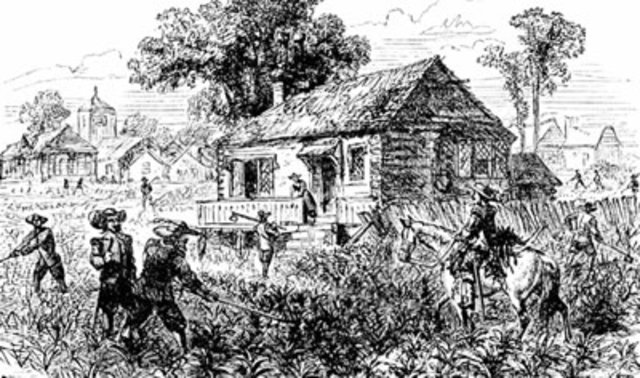 |
| Tobacco in Colonial British America |
Tobacco is an herb native to the Americas. It is believed to have originated in South America. In 1535, Jacques Cartier found natives on the Canadian island of Montreal using tobacco. The root of the word tobacco comes from the native word for pipe or instrument used to consume tobacco among some native people.
Sir John Hawkins took tobacco to England about 1564 although some Englishmen may have been smoking tobacco before this. In less than two centuries, tobacco was the most important export of the English colonies in North America. It remained a main export of the United States until the addictive and destructive effects of tobacco use became widely understood in the 20th century.
Among natives of the Americas, tobacco use generally had a ceremonial aspect. There is disagreement whether tobacco was always ceremonial or was used in everyday life among indigenous Americans. Because Native Americans believed tobacco was a gift from the spiritual world, they used it as a healing herb.
  |
Tobacco was used for toothaches and earaches and as a painkiller and antiseptic. Tobacco was an important gift item to seal commitments and social arrangements among Native Americans. In North America, a pipe was generally used in tobacco ceremonies.
Growth of Colonies
The future of the colonies in British North America, especially Virginia, grew because of the production of tobacco. Tobacco production affected the economic, social, and geographical development of much of the southern United States.
Jamestown colony in Virginia in 1612 was the first to find a means of curing tobacco so it could withstand the trip across the Atlantic to Europe. Sailors spread the habit of pipe smoking to northern Europe. When tobacco was introduced into European society, it became popular as a medicinal herb.
Sir Walter Raleigh persuaded Queen Elizabeth I to smoke tobacco in 1600. Although tobacco growing soon began in many parts of the world, including Europe, the British North American colonies soon became the primary source of tobacco for much of the world.
The English obtained tobacco by growing it in their colonies. King James I of England was one of the first to label smoking a filthy, unhealthful habit of lazy people. However, his dislike of tobacco did not prevent him from collecting taxes on the importation of tobacco into England. The Spanish Inquisition banned two other Native American drugs, coca and peyote but, as had King James I, respected the revenue tobacco brought to Spain and did not ban it.
When the Dutch discovered tobacco, they saw it as a bond with the other major Protestant country of Europe, England. Unlike the English, the Dutch sought to gain tobacco by trading for it. The Dutch focus in the New World became setting up trading posts to buy tobacco rather than establishing colonies to grow it.
The production of tobacco was highly labor intensive. At first, indentured servants from Europe labored to produce tobacco but by 1675, African slaves replaced them. Besides labor, the production of tobacco required large amounts of land.
The coastal areas of Virginia and Maryland had lost nine-tenths of their Native American population in a smallpox epidemic in 1617–19. This left land open for the cultivation of tobacco. As indentured servants won their freedom, they too became tobacco growers.
Soon the North American colonists needed more land to grow tobacco. Tobacco quickly removes the nutrients from the soil in which it is grown. Colonists traded with Native Americans for their land and forced the native population farther from the Atlantic coast.
While the tidewater colonies of Virginia and Maryland were engaged in growing tobacco, some northern colonies were forbidding the use of tobacco. In 1632, the Massachusetts Court of Assistants and General Court levied fines on persons caught “taking” tobacco.
Later the colonies of New Netherland (now New York) banned smoking. Connecticut banned the public smoking of tobacco in 1647. Some bans on smoking were more concerned with the danger of fire caused by smoking materials. The Articles of Piracy had rules controlling the smoking of an open pipe on board a pirate ship.
The Navigation Act in 1651 allowed only English ships to import tobacco into England. This angered the Dutch, the Scottish merchants, and the colonies. The Second Navigation Act of 1660 required colonists to sell tobacco only to the English.
Fully 90 percent of all tobacco imported to Europe came through England. These acts were the beginning of what the colonists in British North America would see as tyrannical treatment by the British government.
Used as Currency
The value of tobacco was so high and reliable that it was used as currency in the colonies. When inferior-quality tobacco appeared in North American exports, Virginia enacted the Inspection Act of 1730.
This regulation of export of tobacco required the product to pass through government-controlled warehouses, where it was inspected and approved for export from Virginia. The size of hogsheads, the barrels in which tobacco was packed, was also regulated. Soon Maryland enacted its own inspection acts.
Since the planting of tobacco quickly exhausted the land, land was not the measure of wealth; rather wealth resided in the number of slave laborers a family owned. Most people who owned land owned slaves. Unlike slave holders in the Caribbean, North American colonists encouraged their slaves to have children. Slaves were not viewed as an expendable commodity.
Tobacco was one reason why the culture of the southern colonies was different from that of the northern colonies. Villages were less important in tobacco-growing areas because people had to live farther apart. Landowning families often controlled the local government, unlike in the more democratic communities in New England.
EmoticonEmoticon